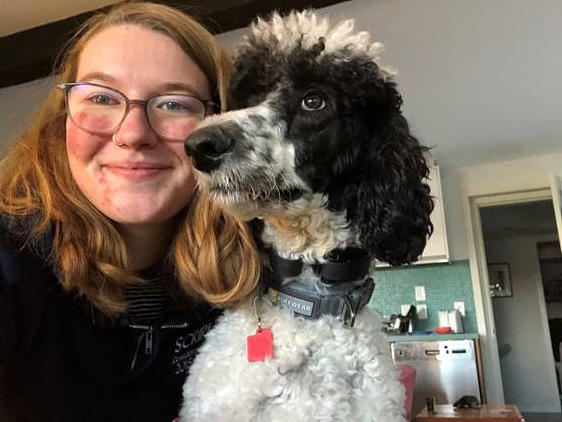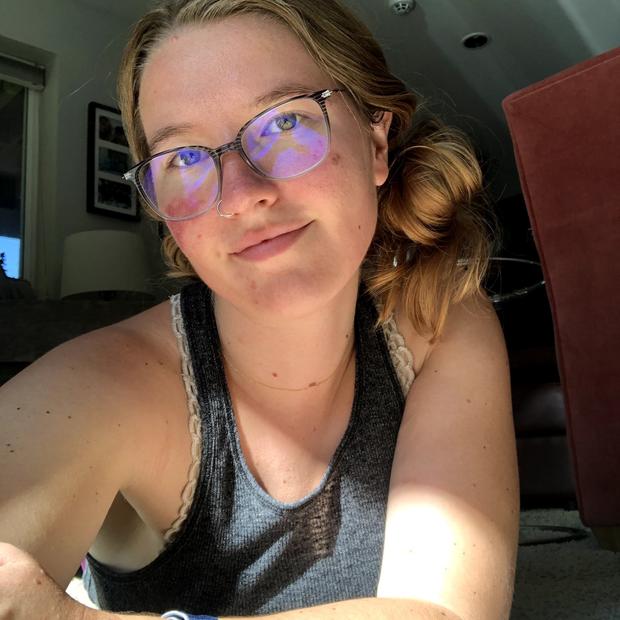But these partial dislocations, or subluxations, occurred with increasing frequency over the next eight years. Ten days before my 16th birthday, I dislocated my kneecap walking around the house, cracking my femur.
After months in a leg brace and constant pleading with my physical therapist, I was allowed to return to the pool. In my only chance to qualify, I made the regional meet. It was the 200-yard freestyle, an eight length race that is technically a sprint. At regionals, a few weeks later, I lapped the girl next to me, and set a personal record.
Crutching up the stairs back to the bleachers after my win, I passed the girl who swam in the lane next to me. “I just got beat by a cripple!” she cry-yelled to her friends. The words echoed through the tiled staircase as I slowly made my way up.
I had never been more proud. Even with one leg, I lapped her. After that win, I was anxious to recover from my broken leg and get back to normal life. If I could do that well with one leg, I thought, imagine how well I could do with two.
But I didn’t return to “normal.” My joints kept subluxing, I was nauseated all the time and increasingly fatigued. Over time, pain crept into my body and never left.
Learning the language of my body
It took six more years before I was diagnosed with Ehlers-Danlos syndrome (EDS), postural orthostatic tachycardia syndrome (POTS) and mast cell activation syndrome (MCAS), illnesses that produce a universe of symptoms, including pain, joint dislocations, fatigue, temperature dysregulation, fainting and increased allergic responses.
Each of these is thought to be rare, but they are commonly found together.
You know the old saying, “When you hear hoof beats, think horses not zebras”? People with Ehlers-Danlos syndrome often characterize themselves as zebras, because our multisystem symptoms are rarely attributed to one common culprit. Research by Dysautonomia International shows that 75% of people with POTS are misdiagnosed initially. All of these illnesses are collections of disparate symptoms, widely impacting the body without clear cause. Most doctors whom I’ve encountered have never heard of them.
These illnesses impact my every decision, and I constantly work to keep their impact small.
Last year, I subluxed my shoulder shaking someone’s hand and then sat through an hourlong interview with a partially dislocated joint, trying to suppress the blistering pain, smiling and waiting.
Sometimes my knee subluxes on stairs.
This is primarily a result of defective collagen and flatter than normal kneecaps. Instead of a notched patella fitting into the bottom of my femur and the tops of my tibia and fibula like a Lincoln Logs cabin, my kneecap is more like a Frisbee on a frozen lake. I am always thinking about how to move to keep my kneecap in place. Whether my knee dislocates or not is also influenced by the shoes I’m wearing, how fast I’m moving, if I’m on my period, if I’m watching where I’m going, or if it’s wet outside, to name a few circumstances.
When I go to weddings and conferences, a walk to a second location in heels quickly turns into that childhood game of walking while holding an egg on a spoon.
I’m allergic to synthetic scents, but when I walk into someone’s home and they are burning incense or a candle, I can’t be around. I will just avoid that corner, or leave early. If it’s a person wearing perfume, things become more complicated. It can be hard to dodge someone and even more difficult to tell them I am allergic to their smell.
My diagnoses helped me understand my body’s logic, the patterns of why it behaved in the ways that it does. But I have often kept the knowledge they conferred to myself. It was easier to quietly endure my pain or discomfort than inconvenience co-workers or friends or even strangers.
I’ve tried to create the most accessible space I can for myself without asking others for help or giving them the tools to fully engage with me.
It took the pandemic to learn that this system is not working.
Surviving a pandemic
In early March, the coronavirus took our collective routines away. Suddenly, doing the things that held my body together — going to physical therapy, swimming and eating dinner on my friends’ couches — posed huge risks to my health and safety and that of my community.
I began quarantine living in a house with two other people I love. In the early weeks and months, we made the best of being together in a small space in which we all lived and worked. We cooked and baked amazing foods, went on long walks, made art, did puzzles, watched silly shows and showed up for one another’s physical and emotional needs. Importantly, we also set up strict boundaries to mitigate exposure to the coronavirus.
Over time, the virus still spreading, quarantine fatigue began to set in.
People started gathering in groups and talked a lot about how they couldn’t wait to be out of isolation. I saw friends on social media going to parties. I saw groups of people in restaurants hugging and sharing food without masks. A lot of people were done staying inside, opting for parties instead of the homemade bread of early March. To me, these were actions dripping with privilege.
My mind started playing out what would happen if I were diagnosed with COVID-19. If I don’t have the energy to actively hold my joints in place, they will dislocate. What happens to them if I am on a ventilator?
My POTS is regulated with medication and movement. After surgeries in the past, the five days of rest have taken me two months to recover from, two months of constant vertigo and lightheadedness, the risk of fainting, the inability to regulate my body temperature. If I am sedated for multiple weeks, will I ever sit up without fainting again?
This worry compounded as we approached summer and things started to shift.
One morning in early June, my roommate told me she felt called to attend a Black Lives Matter protest. After months of extreme caution, she was asking to spend the day in the company of thousands of other people. I wanted her to attend, but I burst into tears. My brain couldn’t comprehend how social distancing would work in a protest. I felt guilty for wanting to hold her back and terrified about what impact her attending could have on my life.
I realized that I hadn’t been clear. I hadn’t expressed my concern about what this virus would do to my body, about the deep panic that any step outside of our collective boundaries instilled in me.
We talked about options for continuing to protest, but in each there were questions about how my access needs would be met. I wanted so badly to show up for Black lives in the same ways my roommates felt safe showing up. It felt like my disability was keeping me, and our house, from being present for the BLM movement. Simultaneously, I was holding the words of writer and disability justice activist Mia Mingus in my head: “The revolution will be accessible or it is no revolution at all.”
For a few weeks, I left my boundaries open because I wanted to continue to live together so badly. I wanted to be a chill, normal girl who could live with the same risk tolerance as my nondisabled pals. I was devastated thinking about the loss of the home we’d created, and all the warmth there.
But our needs were mutually exclusive, and I decided to move out.
For the first time in a really long time, I was fully on my own team.
America loves a supercrip
Americans love a redemption narrative, stories where the underdog overcomes incredible odds and ends up on top. In his essay “The Mountain,” the writer Eli Clare uses the term “supercrip” for moments when this redemption narrative is mapped onto disabled bodies.
He writes, “The nondisabled world is saturated with these [supercrip] stories: stories about gimps who engage in activities as grand as walking 2,500 miles or as mundane as learning to drive. They focus on disabled people ‘overcoming’ our disabilities.... They turn individual disabled people, who are simply leading their lives, into symbols of inspiration.”
These are stories much like the one I told myself about beating the girl next to me at regionals. Supercrip stories (or “inspiration porn,” as it’s also called) are some of the only narratives in which I saw myself represented growing up. Regardless of how they show up, these narratives are harmful because it makes our humanity hinge on extraordinary effort.
For me today, being a supercrip isn’t glamorous. It looks like walking through the grocery store instead of using an electric cart, avoiding sad eyes following me around. It looks like me accepting pain rather than being subjected to pity.
In this story, where I am the supercrip protagonist, the narrator says I should be able to do what other people are doing, how they are doing it. Being invisibly disabled and aiming for these impossible standards of “normalcy” that are inherently out of reach is exhausting. These cultural stories paint me as lazy, rather than in need of accommodations.
I need to tell a new story.
Aiming for neutral
In learning to tell these new stories about myself and my body, I think of a quote from @invalid_art, an Instagram account dedicated to intersectional disability justice that I return to often: “I’m saying something very dangerous to myself if I apologize about my illness being inconvenient for you.”
As we barrel towards another year in pandemic modified life, I have faced these very dangerous statements head on, and learned (and am still learning) not to apologize for my illness inconveniencing other people.
For a long time, I have said that I am aiming for neutrality in life. That way, on good days I will feel extra good, and hard days won’t feel so bad. Recently, I have made a habit of asking myself, “If this is as good as I’ll ever feel, what can I do to make that better?” My answers continue to add up to a full life in my disabled body. Things like getting one of my vitamins as a gummy because the excitement of starting my day with candy will help me remember to take my medicine; finding doctors I trust enough to come to with problems and ask for solutions; sharing when I am frustrated at inherent ableism with my community and trusting them to hold me through it; and, most recently, training a sweet 1-year-old poodle to be my service dog.
Normal is a lie. Our world, with its capitalist, patriarchal, racist foundation, constructs normal as a white, abled, cisheterosexual, colonial ideal. When I stop and think about the context that each of these tiny actions falls within, I don’t want that to be my standard. Instead, I want to aim for this neutrality in my life as part of a loving community, where we can all show up fully to work against these systems. To tear down the foundation and start again. The world that is built through this web of care is stronger and more resilient than any world I could build on my own.






